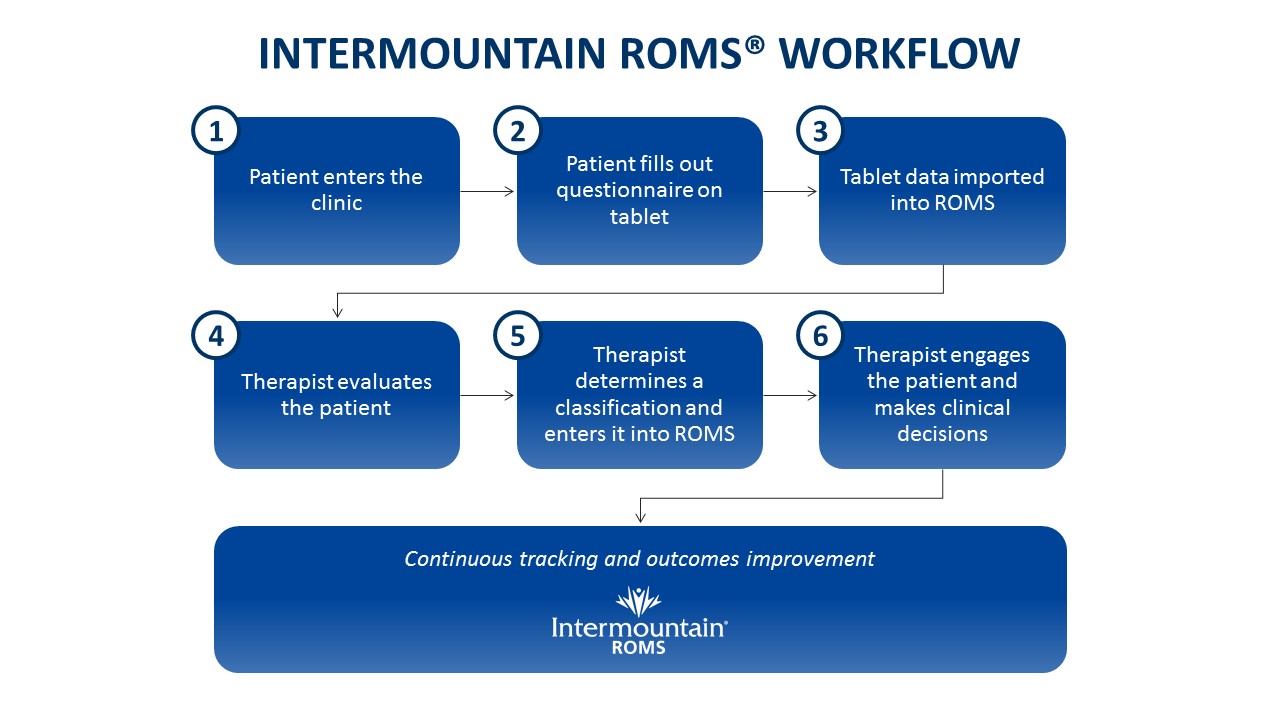Improved Outcomes
Intermountain ROMS® is designed to enable value-based physical therapy care at every stage of recovery. It’s equipped with a proprietary treatment-based classification system of conditions that helps drive clinical decisions at the point-of-care*.
The ROMS classification system creates homogeneous patient subgroups, allowing therapists to make meaningful comparisons and analysis between patients as well as stratify a patient’s risk for delayed recovery. With more than 360 classifications of clinical conditions, this detailed and timely information empowers therapists to tailor treatment that results in improved outcomes. For example, a study published in Physical Therapy: Journal of the American Physical Therapy Association reported, “63.9 percent of Medicare patients with musculoskeletal conditions utilizing ROMS experienced an improved outcome.”
*Intermountain Healthcare Care Process Models use evidence-based guidelines to help providers with clinical decision-making. They are a natural complement to the ROMS classification system and are available upon request.
Visit our Clinical Validation page for more information on published research about ROMS.
Enhanced Value
Not only does Intermountain ROMS® serve as a great asset for therapists in benchmarking patient outcomes and utilization, but with ROMS-guided treatment, therapists, payers, and patients can ready themselves for and thrive in a value-based healthcare environment. These groups will be more attracted to your practice because of the enhanced value you bring through use of Intermountain ROMS.
- Value for patients: ROMS helps patients save money in avoided costs. For example, $1,400 is the average cost savings per lower back pain patient with ROMS-guided treatment. ¹
- Value for payers: ROMS is designed to enable cost-effective, value-based physical therapy care – qualities that payers seek when choosing providers for their panels.
- Value for therapists: ROMS delivers immediate feedback to therapists through classification, tracking, and reports. This feedback increases provider satisfaction because it empowers therapists to continually deliver high quality care.
(1) Fritz, J., Cleland, J., Speckman, M., Brennan, G., & Hunter, S. (2008) Physical Therapy for Acute Low Back Pain: Associations with Subsequent Healthcare Costs, Spine, 1800-1805
Engaged Patient and Care Teams
“…it’s widely accepted that patients who are engaged in their own health care have better outcomes.”
- Harvard Business Review, May 24, 2017
Quality metrics unlocked through Intermountain ROMS® continuous tracking help everyone on the team – patients, therapists, physicians, and payers – better understand and engage in the care provided.
ROMS gives therapists the ability to continuously track a patient’s self-reported pain and disability measures from visit to visit. This allows therapists to bring conversations surrounding outcomes and patient progress into the treatment room. In turn, these conversations engage patients more effectively and lead to meaningful improvement with conditions. Specifically, the ability to continuously track the progress of a patient adds substantial power to outcomes data as therapists are more likely to get an outcome score on a patient’s first visit and final visit.
The Intermountain ROMS® team also hosts a monthly ROMS Learning Community Call for current ROMS clients and those interested in learning more about ROMS. These calls give forward-thinking rehabilitation professionals the opportunity to explore physical therapy and occupational therapy best practices, share lessons learned, and learn more about Intermountain ROMS®. If you are interested in joining our next ROMS Learning Community Call, reach out to us here.
Eliminated Time Burden
Intermountain ROMS® lets therapists efficiently track outcomes without creating a time burden; a therapist will spend less than 30 seconds per patient providing classification data for ROMS. This eliminated time burden makes it easy track what is needed to improve care. Here’s how the ROMS process evolved over two million patient visits to ensure therapists spend as much time with patients and as little time entering data as possible:
- The survey scores and the treatment classification data input is done by office staff
- The physical therapist determines the treatment-based classification based on the patient evaluation
- The physical therapist simply selects a classification from a drop-down menu – it takes seconds!
- Customizable reports on outcomes are on-demand and easily accessible
See the graphic below to better understand the workflow process for collecting data in ROMS.

Simplified Reporting
Intermountain ROMS® simplifies reporting in your practice – in real time. The on-demand knowledge gained through ROMS reporting enables therapists to deliver better, more informed care to their patients. ROMS reports provide actionable information, are fully customizable, and can help therapists do the following:
- Easily understand analysis of outcomes
- Compare outcomes and outcome changes across facilities, clinics, therapists, and date ranges
- Track patient progress and engage patients with their individual outcomes report
- Quickly compare current and previous outcome surveys
- Track collection of outcomes and assignment of classification
- Determine effectiveness of changes in care process guidelines
- Track the failure to progress rate among patients to evaluate care process guidelines and performance of clinics and therapists
- Segment your outcomes by referring physician
- Benchmark reports to help drive referrals and negotiate with payers
- Better understand your mix of patients and volume of different classifications to understand how to best focus your training efforts
- Understand optimal number of visits for a given classification and patient
- Identify utilization of visits, payer mix, types, and frequency of patients’ clinical conditions
- Track frequency to assist with prioritizing efforts (see example below)
